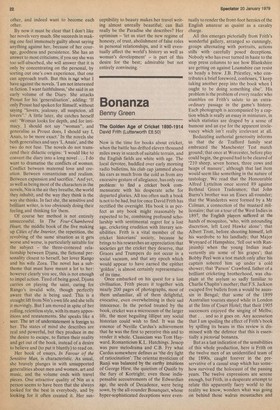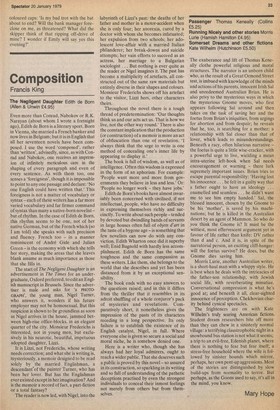Bonanza
Benny Green
The Golden Age of Cricket 1890-1914 David Frith (Luttervvorth £8.50) Now is the time for books about cricket, when the battle has drifted eleven thousand miles away in search of suitable terrain, and the English fields are white with age. The local devotee, huddled over early morning radio bulletins, his club cap jammed about his ears as much from the cold as from any excessive gesture of allegiance, has only one problem: to find a cricket book commensurate with his desperate ache for departed glories. All too often such a book is not to be had, but for once David Frith has rectified the oversight. His book is as perfect as any book might reasonably be expected to be, combining profound scholarship with sentimental regret for a lost age, cricketing erudition with literary sensibilities. Frith is a vital member of the cricket historians' society, because he brings to his researches an appreciation that societies get the cricket they deserve, that Graces and Trumpers do not occur in a social vacuum, and that any epoch which would appear to have earned the epithet 'golden', is almost certainly representative of its time.
Once embarked on his quest for a lost civilisation, Frith pieces it together with nearly 200 pages of photographs, most of them unfamiliar, all of them delightful, evocative, even overwhelming in their sad innocence. In the period treated by the book, cricket was a microcosm of the larger life, the most beguiling lilliput any social historian could wish to find. It was the essence of Neville Cardus's achievement that he was the first to perceive this and to render it whole. Classicism was Tom Hayward, Romanticism K.L. Hutchings. Jessop was pure melodrama and C.B. Fry what Cardus somewhere defines as 'the dry light of ratiocination'. The oriental mysticism of Ranji was balanced by the earthy intuitions of George Hirst, the quietism of Quaife by the fury of Kortright; even those indispensable accoutrements of the Edwardian age, the seeds of Decadence, were being sown, by the all-rounder Bosanquet, whose hyper-sophisticated deceptions were even tually to render the front-foot heroics of the English amateur as quaint as a cavalry charge.
All this emerges pictorially from Frith's wonderful gallery, arranged so cunningly, groups alternating with portraits, actions stills with carefully posed deceptions. Nobody who has ever turned in haste to the stop press columns to see how Blankshire are getting on against Loamshire can resist so heady a brew. J.B. Priestley, who contributes a brief foreword, confesses, 'I keep taking another peep into the book when I ought to be doing something else'. His problem is the problem of every reader who stumbles on Frith's salute to an extraordinary passage in the game's history. Each photograph is accompanied by a caption which is really an essay in miniature, in which statistics are draped by a sense of humour and an eye for the apparent irrelevancy which isn't really irrelevant at all.
Bedazzling authorial generosity informs us that the de Trafford family seat embraced the Manchester Test match ground; that once at Worcester, before play could begin, the ground had to be cleared of '210 sheep, seven horses, three cows and heaps of manure', although that last item would seem like something in the nature of tautology. We read that the Honourable Alfred Lyttelton once scored 89 against Bethnal Green Tradesmen; that John Burns's brother was an Essex all-rounder; that the Wanderers were formed by a Mr Colman, a connection of the mustard millionaire; that on a tour of the West Indies in 1897, the English players suffered at the hands of mosquitos, 'who, with astounding discretion, left Lord Hawke alone'; that Albert Trott, before shooting himself, left his wardrobe to his landlady; that Major Wynyard of Hampshire, 'fell out with Ranjitsinhji when the young Indian inadvertently ate some of his grapes'; that Bobby Peel won a test match only after his captain sobered him up under a cold shower; that 'Parson' Crawford, father of a brilliant cricketing brotherhood, was chaplain at the asylum so sadly familiar to Charlie Chaplin's mother; that F.S. Jackson escaped five bullets from a would be assassin in Bengal; that some of the 1899 Australian tourists stayed while in London at the Inns of Court Hotel; that their 1905 successors enjoyed the singing of Melba; that . . . and so it goes on. Any accusation that I am spoiling the effect of Frith's book by spilling its beans in this review is dismissed with the defence that this is essentially a pictorial bonanza.
But as a last indication of the sensibilities of this whole production, here is Frith on the twelve men of an unidentified team of the 1890s, caught forever in the preservative of a casual snap which has somehow survived the holocaust of the passing years. The twelve expressions are serene enough, but Frith, in a desperate attempt to relate this apparently faery world to the reality we know, wonders what was going on behind those walrus moustaches and coloured caps: 'Is my bad trot with the bat about to end? Will the bank manager foreclose on me, as threatened? What did the skipper think of that ripping off-drive of mine? I wonder if Emily will say yes this evening?'



































 Previous page
Previous page